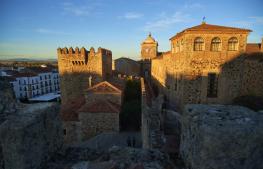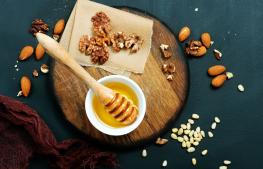Dehesa de Extremadura
The best ham in the world
Extremaduran ham is the best Iberian ham in the world. This is not something that happens by chance.
For a ham to become a delicacy and be covered by the Dehesa de Extremadura Protected Designation of Origin, it is necessary to follow some strictly established steps:
The Iberian pig has to feed on mother’s milk until it is 60 days old, and then it feeds on feeding stuffs and grasses from the dehesa grassland, always roaming free. Between the ages of 12 and 14 months, it begins to be fed using the free-range mast-feeding system, consuming between six and 10 kilos of acorns every day, as well as legumes, grasses and three kilos of grass per day.
The DOP Dehesa de Extremadura only certifies 100% Iberian pigs or pigs that are at least 75% Iberian breed.
The pigs, and therefore the resultant hams and shoulders, are classified into two types
according to the type of food they eaten: bellota, which is slaughtered immediately after exclusively feeding on acorns, grass and other natural resources of the dehesa, without the possibility of providing supplementary feeding.
Bellota hams and shoulders will have the black seal (100% Iberian) or red seal (75% Iberian breed) with the logo and emblem of the regulatory board. In both cases, the bellota label will be red.
The other type, cebo de campo, comes from pigs fattened on feeds and natural grasses from the dehesa. These pigs are managed on extensive farms and complete their feeding with a minimum of 90 days in the open countryside until they are slaughtered. Cebo de campo hams and shoulders will have a green seal and label.
Dehesa de Extremadura ham is characterised by being a slender piece, with a long, thin shinbone, black hoof, skin trimmed in a V shape and covered with a shiny layer of fat.
The sliced ham has a tone between pinkish and dark red, with characteristic intermuscular fat. It has a sweet, pleasant flavour full of nuances.
The DOP Dehesa de Extremadura is known both nationally and internationally, with commercial contacts established with Japan and China. A gastronomical gem that has become one of the most well-regarded delicacies in the world, not only due to its fine flavour, but also due to being a healthy product thanks to its high percentage of oleic acid, with the ham’s intramuscular fat giving it juiciness.
Weather
Cáceres
15Dec

7 ºC
13 ºC
16Dec

7 ºC
12 ºC
17Dec

7 ºC
14 ºC
18Dec

4 ºC
15 ºC
19Dec

5 ºC
10 ºC
20Dec

5 ºC
11 ºC
If you like Dehesa de Extremadura you will like this too...
Villuercas-Ibores Honey
The honey with Protected Designation of Origin Villuercas-Ibores Honey is the natural product produced by European honey bees.
La Vera paprika
La Vera paprika has its history in the province of Cáceres thanks to Holy Roman Emperor Charles V.
Tomatoes
The town of Miajadas, in the south of the province of Cáceres, is closed linked to irrigated land, where rice and tomato growing play key roles.
More things you can find in Cáceres

Old Town of Cáceres
The decree declaring Cáceres as a Monumental Site was published on 21 January 1949, and in 1986 UNESCO included the Old Town of Cáceres in its list

Festivals of Tourist Interest
The province of Cáceres is home to one Festival of International Tourist Interest and two festivals declared as being of National Tourist Interest.

Monumental city of Cáceres
The topography plays an important role in the urban development of Cáceres, as the city stands on uneven ground, between the Sierra de la Mosca mou






